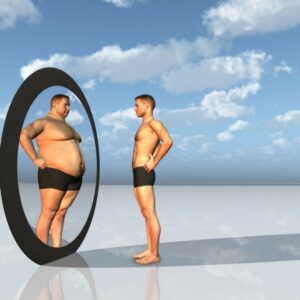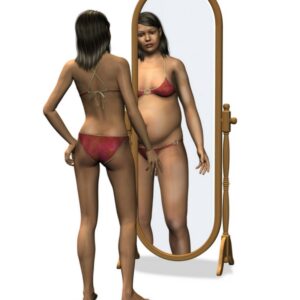







This is a broad term, describing a wide spectrum of psychiatric and behavioural problems, but basically referring to a distorted and unhealthy attitude towards food and eating.
One’s relationship with food starts at birth; suckling immediately after delivery. This is a warm, safe, rewarding and loving experience, and imprints an immediate link between food and love. This pleasant perspective on food is meant to persist through life celebrating and enjoying food as a means of love, reward, comfort and nurturing.
However, through childhood and adolescence, one’s belief systems surrounding food, eating, hunger, reward and comfort all get shaped in different ways. Should these belief systems be shaped by unhealthy psychological influences, or by pseudoscientific misinformation, then a pathological, extremist and obsessive relationship with food and eating can develop. This leads to irrational measures being taken, both behaviourally and psychologically, attempting to control impulses that appear to be increasingly out of control.
This is an eating disorder. There are different types. They are varied, but stem from a similar core: fear of being out of control of food, eating and weight.
I treat:
- Binge Eating Disorder
- Anorexia Nervosa
- Bulimia Nervosa
- Eating Disorder Not Otherwise Specified
- ‘Orthorexia’.
- Listening, understanding and keeping a completely non-judgemental environment where vulnerability is respected and protected. I am here to help, not to exploit.
- Untangling incorrect beliefs and attitudes regarding food and eating.
- Teaching how a calorie is not a calorie, and how different foods react differently within the body, changing the metabolism and substrate usage. This is a very large, and ongoing, part of my work with the eating disorder sufferer. Most beliefs around what is ‘healthy’ or ‘unhealthy’; what is ‘good’ or ‘bad’ and what is ‘safe’ or ‘fattening’, derive from popular statements and fads, derived from unqualified and self-proclaimed ‘nutrition gurus’. Undoing these pathological beliefs requires timely, easy-to-understand explanations of fairly advanced physiological concepts. Only with this knowledge and full understanding, can the patient begin to understand WHY certain foods have certain effects on weight. Bit by bit, the elucidation of the scientific workings of the body is the only way that deep-seated fears of food can be slowly abandoned.
- Teaching how different foods, types of foods, substrates and nutrients can influence the brain and thinking. Both psychologically (thinking habits and beliefs) as well as psychiatrically (chemicals in our brains causing emotional states). Learning how cravings can be induced, for instance, helps the individual understand how the feeling of ‘being controlled by food and hunger’ actually begins. This understanding and scientific knowledge (which only a dietician is trained to disseminate) brings a long-lost confidence in food and hunger so that healing can begin, and food becomes the ‘friend’ again. This takes time, but the transformation is often much quicker than many expect.
- Handing the pace of the therapy largely to the patient. What I have found is that many other practitioners that eating disorder patients have consulted with, have a ‘parent-child’ relationship with their patients, whereby the expectation is placed upon the patient to ‘do what the practitioner tells them to do’ in order to be acceptable. I disagree with this approach, and take the stance that I WORK FOR THE PATIENT. I am the teacher and the guide, but I work towards promoting the patient to take control of the healing process, and the patient merely using me as a ‘map’ as much as they wish.
- Believing that the patient’s family should play as much of a role in the therapy as possible. I work closely with the family and significant others, insofar as to explain the process to those who care. Again, once loved ones comprehend the disorder, where it came from, how it works and the specific methods we are using to heal it, support becomes easy, and home conflict eases through understanding.
- Avoiding promoting the disorder by enforcing moderation. Trying to conduct therapy based on methods to shield the patient from temptation of unhealthy food, (or trying to instil a sense of ‘self-control’ when around ‘trigger foods’) will NOT result in a long-term success. I encourage natural impulses and indulgences as they arise, but with dietetically-supervised interaction, as the patient and family starts to understand each food type and its effects, and learn to understand HOW foods can all fit into a healthy and delicious diet.
- Undoing the illogical and harmful dogma of ‘Good’ and ‘Bad’ food, makes way for the fact that “All Food Fits”. This plays an integral part in freedom of choice of all kinds of foods without demonization of any one type as being harmful or magically ‘fattening’ if eaten at all.
- I also disagree VERY strongly with the common attempt at getting the patient to view food ONLY as a source of nourishment. In fact, my approach is in sharp contrast to this; I teach that food is INEXTRICABLY linked to love, reward, safety and happiness, and should be celebrated as such. Learning how to indulge in certain ways that will not and can not result in weight gain, leads to further freedom to explore pleasure and enjoyment. Knowledge brings freedom. Freedom brings confidence.
- I work closely with the patient’s psychiatrist, doctor, psychologist and specialist, to ensure a co-ordinated approach to therapy and recovery, under the consent of the patient at all times.


